Written by: Zahrah Mazhar
Posted on: July 14, 2014 | 
Galata Tower
The skyline of Istanbul is dominated by the sharp minarets and impressive domes of the hundreds of mosques in the city but there is one landmark, across the Golden Horn from the old city, which stands apart for its unique medieval structure: the Galata Tower. With its conical cap, the nine-storey tower looms over the buildings on the north bank of the Golden Horn, beckoning people to the liveliest district of Istanbul, Beyoğlu.
As is the case with most landmarks in Istanbul, the journey to the cylindrical tower turned out to be a day’s worth of Turkish delights – clear blue water, bustling piers, historical bridges and of course, glorious food. My trail started from the heart of the old city, Sultanahmet, from where one can take the tram or bus to Eminönü Pier, but for the most scenic route, I’d recommend walking down along the Golden Horn.
Start early so that you can cover the Eminönü Pier, Beşiktaş and Beyoğlu in one day. The pier stretches along the Golden Horn and connects to Karaköy, one of the popular neighbourhoods of Beyoğlu, through the Galata Bridge. As soon as I approached the pier, I found myself amid a flurry of activity – there were tourists excitedly figuring out the best routes to the Asian side or the Prince Islands, guides trying to sell the ‘best’ Bosphorus cruise for the ‘best’ rate, and daily commuters taking a ferry to get to work. There is no doubt that Istanbul has a remarkable public transport system which provides access to almost every part of the city. You have a network of trams, buses, metro lines and ferries at your disposal to get around the city as well as the nearby islands which are ideal for a one-day excursion.
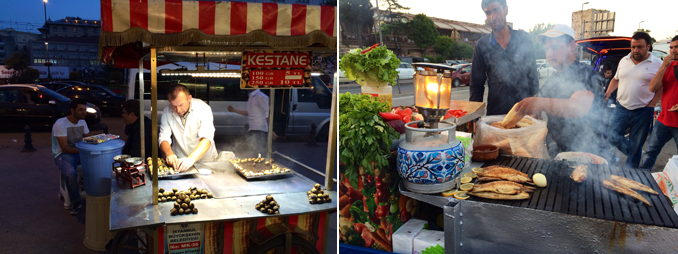 |
Street goods and Balik Ekmek at Eminonu pier |
Apart from being the centre for multiple ferry docks, Eminönü Pier is also the hub of Istanbul’s street food which is easy on the eyes as well as on the pocket. If you haven’t had breakfast, grab a Simit, or if just want a snack, try the corn or the roasted chestnuts. And if you’re in the mood for seafood at the pier, stop by one of the many vendors selling fresh mussels or go for the famous fish sandwiches, Balik Ekmek. A number of tiny grills are set along the waterfront neighbourhood, with wooden tables and stools scattered about in case you want to sit down while enjoying the grilled mackerel sandwich.
To get to Beyoğlu, once known as Pera, you'll have to cross the Galata Bridge. While it may not be as grand and as picturesque as the Bosphorus Bridge, it is significant for its design and history and is often referred to as the passageway to the old city of Constantinople. Connecting the two parts of Europe, the bridge was originally built by the mother of Sultan Abdülmecid I in 1845. It was rebuilt five times at different locations on the Golden Horn and what stands today is the fifth version of the Galata Bridge. The pedestrian walkway under the bridge is lined with seafood restaurants and passing through that area will heavily depend on your dodging abilities. I had no idea of the army of restaurant owners and waiters that would descend on me and my fellow traveller, but there we were being cajoled by one restaurateur after the other to take a table at their eatery. My advice to all those who dare venture under the bridge: keep your head down and quickly make your way to the shore before you’re sucked into the tourist trap – meaning paying for food way more than you should have!
After finally making it through the walkway (we walked over the bridge on the way back) we arrived at Karaköy. From there you can take the tram to Kabatas, walk a little further ahead and you’re in Beşiktaş – one of the oldest neighbourhoods of Istanbul which has now transformed into one of the city’s trendiest areas owing to the influx of luxury hotels, premium boutiques and swanky apartments. The municipality has a number of well known neighbourhoods, including the ever-popular Bebek along the Bosphorus, but for the most gorgeous views of the Bosphorus Bridge, head to Ortaköy.
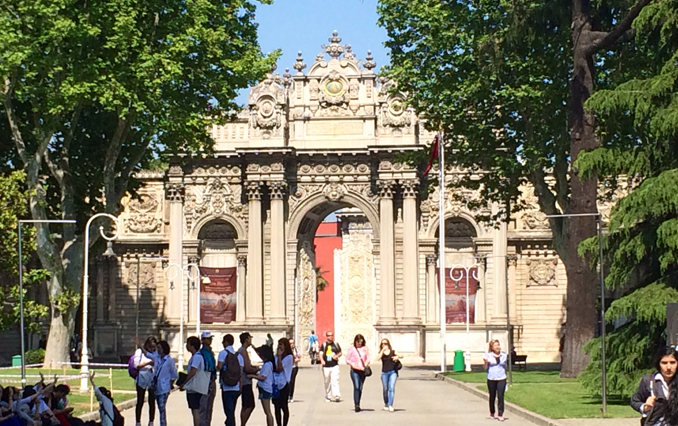 |
Dolambache Palace |
On the way, you’ll come across Dolmabahçe Sarayi, the largest palace in Turkey and Istanbul’s first European-style palace filled with gold and crystal. Grand in the truest sense, the palace was built on the orders of Sultan Abdülmecid I in 1843 but the Ottoman Empire’s administrative centre didn’t move from the Topkapi Palace till 1856. It was home to six sultans and also where the founder of the Turkish Republic, Mustafa Kemal Atatürk, breathed his last. I normally stay away from cafes of popular tourist spots but the palace’s Saat Kulesi Kafeterya is definitely worth a visit – I honestly don’t remember the food much, but with tables right next to the Bosphorus, it’s not the menu you’ll be looking at.
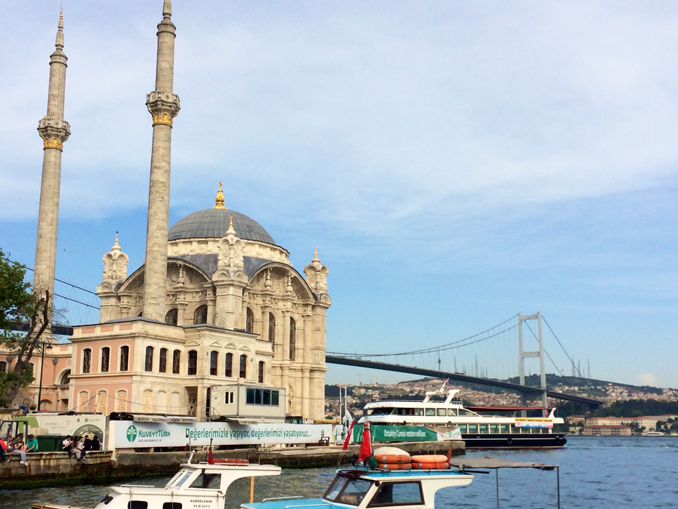 |
Ortakoy Mosque and Bosphorus Bridge |
After passing by at least half a dozen luxury hotels on the waterfront, palaces and renowned educational institutions, you’ll find yourself in the chic neighbourhood of Ortaköy. The area has plenty of character if you’re in the mood to explore but nothing beats the lively atmosphere at the Ortaköy pier square where the view of the Büyük Mecidiye Camii (Grand Imperial Mosque of Sultan Abdülmecid I, also known as Ortaköy Mosque) against the Bosphorus Bridge makes it easy to lose track of time. The Neo-Baroque mosque, right under the bridge, is surrounded by cafes, tea houses, food stalls, shops selling jewellery and artwork, and even street shows. The waterside cafes and promenade around the mosque have made Ortaköy a popular location for tourists and residents alike, especially during the festive month of Ramadan.
Head back towards Karaköy a little before sunset so you can climb the steep hillside towards the Galata Tower, Galata Kulesi in Turkish, and catch beautiful panoramic views of the city as the first rays of twilight fall over the mosques of the old city. The tower was built in 1348 and was known as the Tower of Christ (Christea Turris). It served as a watchtower, particularly to keep an eye out for fire outbreaks in the city. After have undergone many restorations, it is used today solely for tourism with its viewing balcony almost always full. The narrow streets around the tower are a mix of cafes, art galleries, quirky shops and busy restaurants and, as we discovered, the rest of the district was no different.
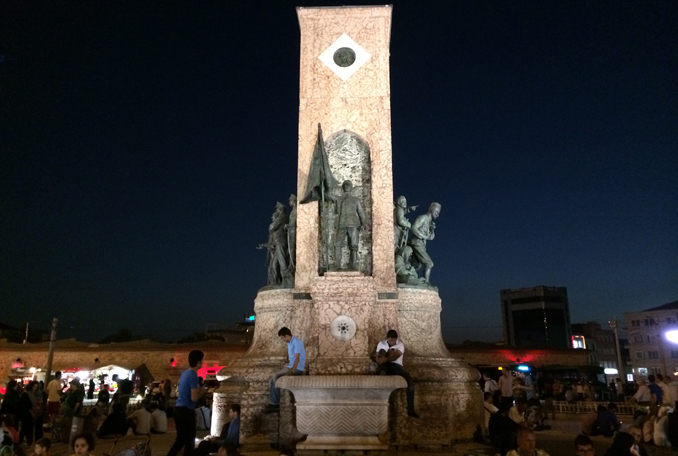 |
Taksim Square |
Beyoğlu most definitely lives up to its reputation as the centre of Istanbul’s nightlife and so does Istiklal Avenue (İstiklâl Caddesi) as the heart of the district. In the 19th century the street was called Grand Avenue (Cadde-i Kebir) but with the arrival of European foreigners, it came to be known as ‘Grand Rue de Pera’. Considered the more modern part of Istanbul, the avenue was home to embassies, foreign merchants, theatres, intellectuals, patisseries and posh boutiques. Though it lost its charm as an upscale avenue, İstiklâl Caddesi became the undisputed It place in town for a great night out by opening doors to clubs, pubs, galleries, Fal cafes and restaurants. As you walk on the brightly lit street, music blares out of the clubs on the first and second floors, street performers bring people on the crowded avenue to a stop with their antics and the combined aromas of donors, kebabs and nargile (Turkish hookah) waft out from the cafes and restaurants.
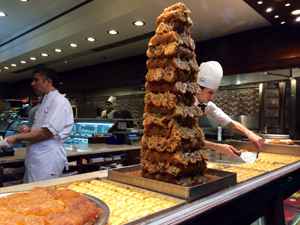 |
A shop in Istiklal Avenue selling Turkish sweets |
You’ll be spoiled for choices when it comes to food as the eateries go all the way up to the end of the street to Taksim Square (Taksim Meydani) – one of the most known landmarks of the city. Also known as the Monument of the Republic, the area over the years has been a popular choice for massive demonstrations and political protests. Not to say the venue hasn’t seen happier times, as parades, celebrations and other social gatherings also take place at Taksim.
Top your night off with something sweet from the endless, tempting choices available at the iconic Turkish delights’ shop at Taksim, Hafiz Mustafa 1864, take your pick from the metro and tram for the ride back and bid adieu to Beyoğlu.
All images provided by author
Click to view picture gallery
You may also like: